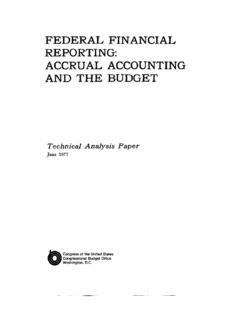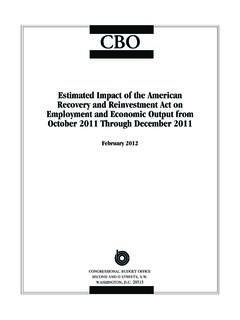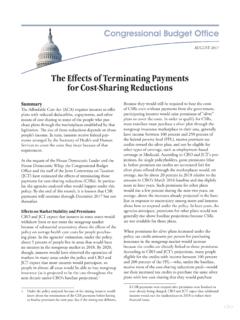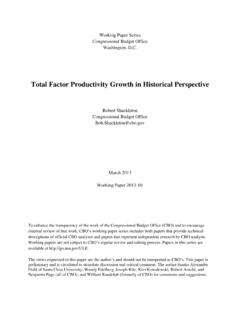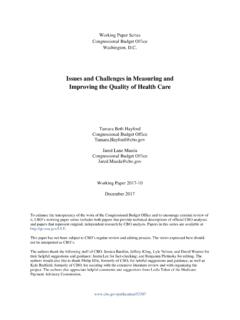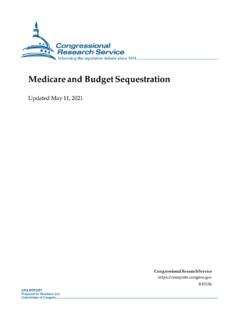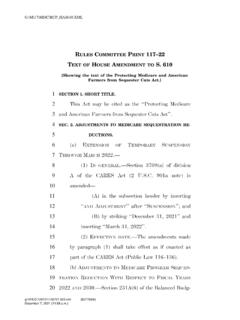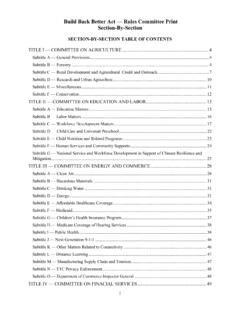Transcription of Common Budgetary Terms Explained
1 | @uscboCongressional budget OfficeNonpartisan Analysis for the CongressDecember 2021 Common Budgetary Terms Explained This guide briefly explains in plain language the differences between some Common Budgetary Terms . (For detailed definitions, see CBO s Glossary.)What s the Difference Between .. budget Authority, Obligations, and Outlays? budget authority, obligations, and outlays are related Terms that describe the funds provided, committed, and used for a program or called funding, budget authority is the amount of money available to a federal agency for a specific purpose. The authority to commit to spending federal funds is provided to agencies by law. The amount of budget authority provided can be specific such as when the Congress provides a set amount for a program or activity or indefinite. For example, the federal crop insurance program uses indefinite budget authority to provide insurance products to farmers and ranchers at subsidized rates.
2 Once budget authority has been provided for a given purpose, an agency can incur an obligation a legally binding commitment. For example, the Department of Defense incurs an obligation when it enters into a con-tract to purchase equipment. Often, the funds must be obligated within a specified period typically one or sev-eral years although some funds are available indefinitely. If funds are not obligated within the specified period, they expire (or lapse) and are no longer available for general, outlays occur when a federal agency issues checks, disburses cash, or makes electronic transfers to liquidate (or settle) an obligation. That occurs, for example, when a federal agency deposits grant funds into recipients accounts or the Social Security Administration disburses payments to beneficiaries. (For more infor-mation about how the Congressional budget Office estimates outlays, see CBO s Waterfall Model for Projecting Discretionary Spending, March 2021.)
3 Authorization Acts and Appropriation Acts?Authorization acts and appropriation acts provide the legal authority for the government to operate and fund programs or activities. Authorization acts establish or continue the authority for agencies to conduct programs or activities. Such laws delineate a program s Terms and conditions often, its duration and eligibility rules. When an authorization act provides funding directly from the Treasury (so that the program does not require an annual appropriation), that amount is classified as mandatory spending. Other authorization laws establish or continue discretion-ary programs, which receive their funding in appropria-tion acts. Those authorization laws may include language such as there is authorized to be appropriated [a certain amount of money], indicating that any funding for the program must be provided in subsequent appropriation acts. (For more information, see Expired and Expiring Authorizations of Appropriations: Fiscal Year 2021.)
4 Appropriation acts make funding available to federal programs and activities by providing budget authority to federal agencies, usually by specifying an amount of money for a given fiscal year. In the absence of an authorization act, an appropriation act by providing funding can also authorize agencies to operate a program or to undertake an activity. The Congress may consider multiple regular appropriation bills in a given year or provide all discretionary appropriations in one Common Budgetary Terms Explained December | @uscbo2omnibus bill. When regular appropriations are not in place by October 1, the start of the fiscal year, a continu-ing resolution can be enacted to provide temporary bud-get authority for a specified period, typically in amounts equal to appropriations for the previous year. The Congress can also supplement regular appropriations that have already been enacted. In 2020, for example, lawmakers enacted four laws that provided supplemental appropriations in response to the coronavirus pandemic to give financial assistance to individuals, businesses, and other.
5 Discretionary and Mandatory Spending?The labels discretionary and mandatory identify the process by which the Congress provides funds for federal programs or activities. The distinction is generally made at the time a law creates a program or provides authority to undertake an activity. The Congressional rules and statutory procedures that govern budget enforcement differ for those two types of spending results from budget authority provided in appropriation acts. (A few mandatory pro-grams are also funded through appropriation acts; those programs are discussed below.) Through the appropri-ation process, the Congress decides on the amount of funding for a program (such as veterans health care) or an activity (such as collecting entrance fees at national parks). Administrative costs to pay salaries, for exam-ple are usually covered through those a share of all federal outlays, discretionary spend-ing has dropped from 60 percent in the early 1970s to 30 percent in recent years.
6 Almost all defense spending is discretionary, and about 15 percent of pandemic-related spending was classified as statutory limits (often referred to as caps) on most types of discretionary budget authority were in place in many years, none are in effect now. The budget Control Act of 2011 established caps for fiscal years 2012 to 2021; no caps were established for subsequent spending (also called direct spending) consists of outlays for certain federal benefit programs and other payments to individuals, businesses, non-profit institutions, and state and local governments. That spending is generally governed by statutory criteria and, in most cases, is not constrained by the annual appropriation process. Social Security, medicare , and Medicaid are the three largest mandatory programs. Funding amounts for a mandatory program can be speci-fied in law or, as is the case with Social Security, determined by complex eligibility rules and benefit formulas.
7 The authorization laws that specify the amount of funding for mandatory programs may use language such as there is hereby appropriated [a particular amount of money]. Funding for some mandatory programs for exam-ple, the Supplemental Nutrition Assistance Program, veterans disability compensation and pensions, and Medicaid is appropriated annually. Spending on those programs is called appropriated mandatory spending. Those programs are mandatory because authorization acts legally require the government to provide benefits and services to eligible people or because other laws require that they be treated as mandatory; however, appropriation acts provide the funds to the agencies to fulfill those obligations. As discretionary spending s share of total federal spend-ing has declined, mandatory spending s share has grown, from about 30 percent in the early 1970s to 60 percent in recent years. The remaining 10 percent of total federal outlays consists of net spending on interest (primarily interest payments on the federal debt).
8 Under the Statutory Pay-As-You-Go Act of 2010 (often called S-PAYGO), the Congress established Budgetary reporting and enforcement procedures for legislation that affects mandatory spending or revenues. That act can trigger across-the-board cuts in funding (known as sequestration ) for mandatory programs. (For more information, see The Statutory Pay-As-You-Go Act and the Role of the Congress.) December 2021 Common Budgetary Terms | .. Rescissions and Reappropriations?Rescissions and reappropriations are used by the Congress to change the availability of unused (that is, unobligated) budget authority. Rescissions cancel previously provided budget authority before it expires under current law. Reappropriations extend the originally specified period of availability for unused budget authority that has expired or that would otherwise expire. Generally, that reappropriated budget authority is for the originally stated purpose, but sometimes it can be used for a different purpose.
9 Cash Accounting, Accrual Accounting, and Fair-Value Accounting?Cash, accrual, and fair-value accounting are ways to esti-mate and record the cost of government activities in the federal budget . Those methods differ in Terms of when the commitment or the collection of Budgetary funds is recorded in the budget and whether they measure the market value of the government s obligations. (For more information, see How CBO Produces Fair-Value Estimates of the Cost of Federal Credit Programs: A Primer and Cash and Accrual Measures in Federal Budgeting.)Cash accounting records costs when payments are made and revenues when receipts are collected. Most spending in the federal budget is recorded on a cash basis. Accrual accounting records costs when goods are received or services are performed (rather than when they are paid for) and revenues when they are earned (rather than when actual payments are received). Under that accounting method, the estimated cost of Budgetary activities is the sum of all cash flows associated with that activity, expressed in a single number called a present value.
10 The present value depends on the rate of inter-est, known as the discount rate, that is used to translate future cash flows into current dollars. (Interest on the public debt is recorded on an accrual basis but not as a discounted present value.)The Federal Credit Reform Act of 1990 (or FCRA) requires the costs of federal credit programs namely, the costs of the government s direct loans and loan guarantees to be recorded as a present value at the time a loan is made. FCRA also requires the discount rate to be the interest rate on Treasury securities with the same term to maturity as the associated cash flow. For exam-ple, cash flows in the second year of a federal loan or loan guarantee are discounted using two-year Treasury rates. Federal credit programs include certain housing pro-grams, postsecondary education loans, commercial loans, and loans to small businesses. Like FCRA accounting, fair-value accounting is a form of accrual accounting, but it uses market prices to mea-sure the costs of loans and loan guarantees.
